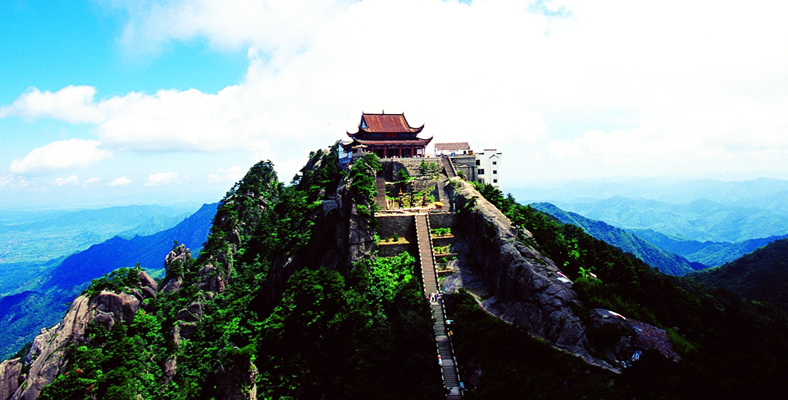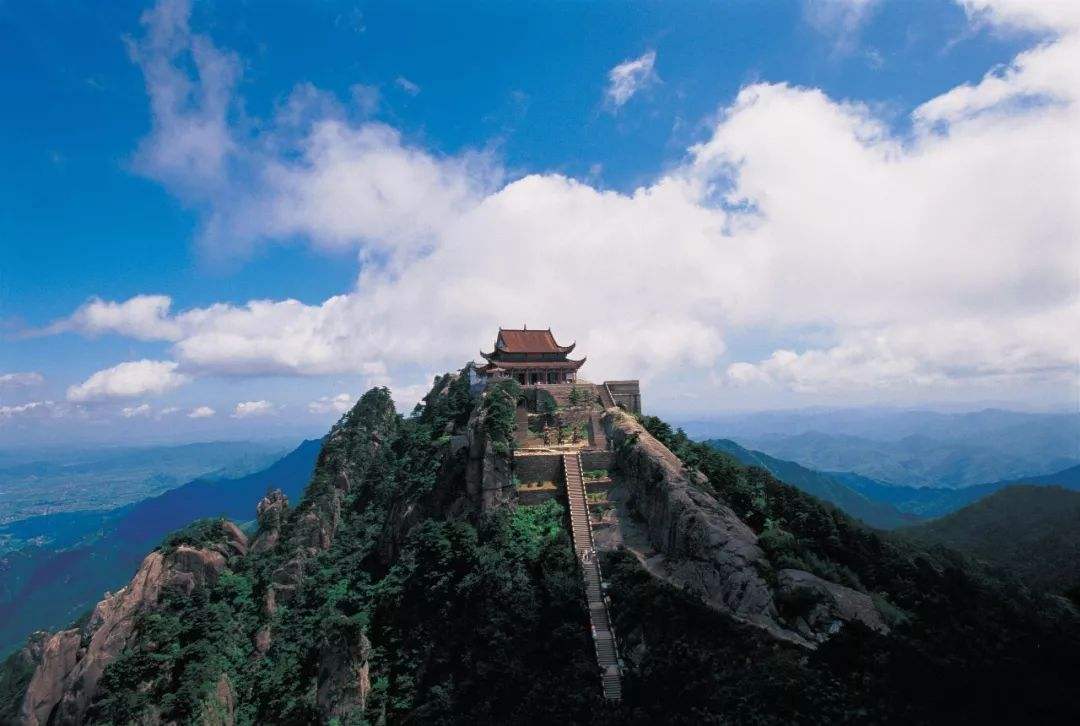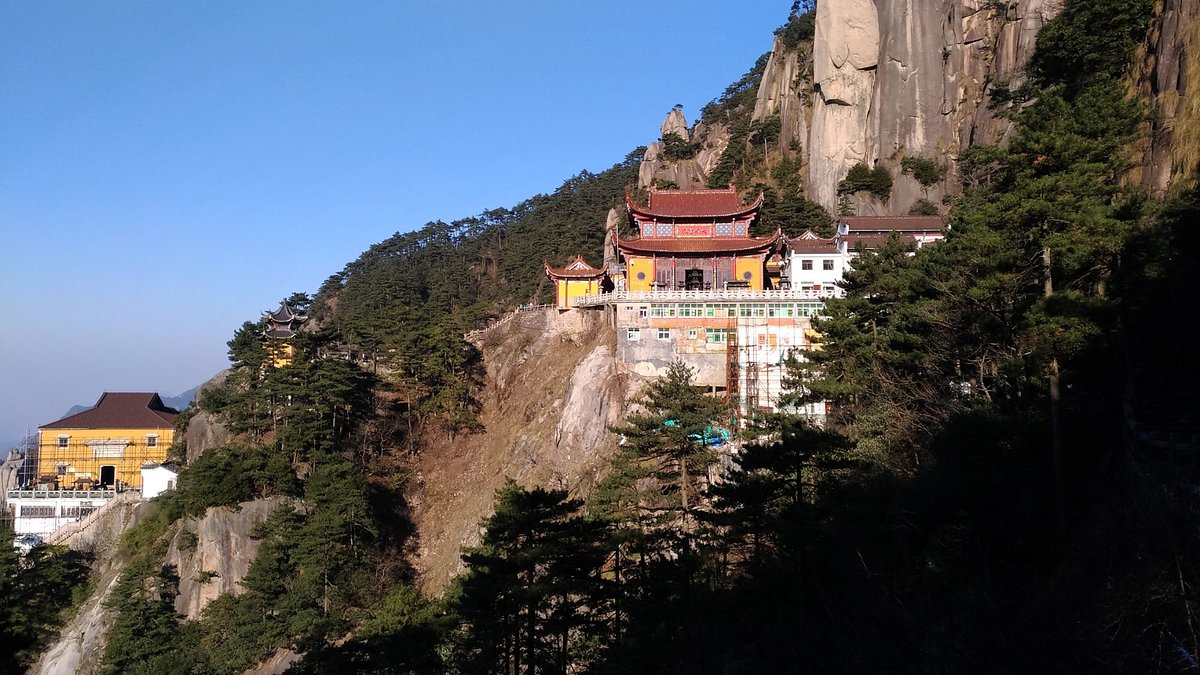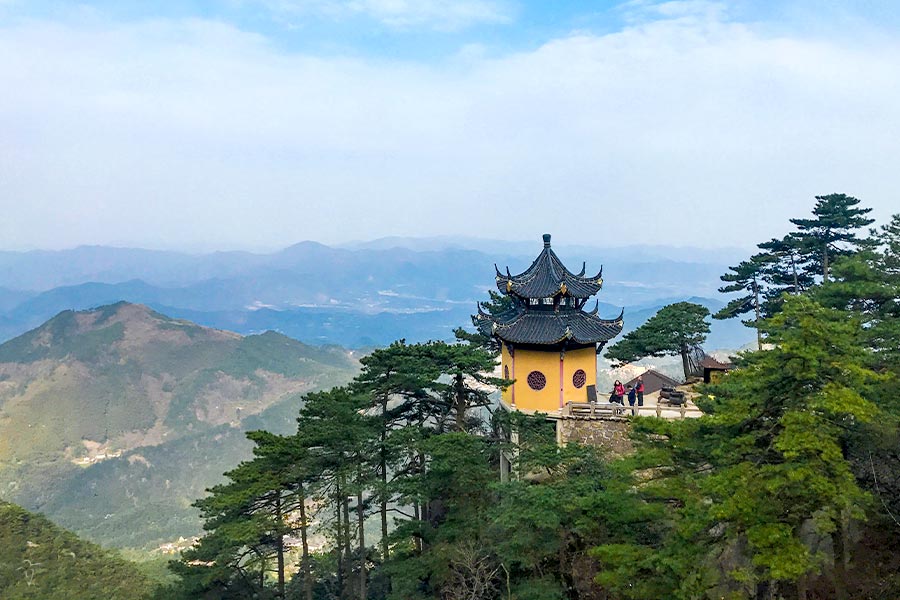Is Jiuhua Mountain the Most Serene Destination in China?
An Essential Guide to Visiting Jiuhua Mountain
Nestled in the heart of Anhui province, Jiuhua Mountain (九华山) stands as one of China’s Four Sacred Buddhist Mountains, captivating visitors with its ethereal beauty and profound spiritual significance. What sets Jiuhua apart is not merely its stunning vistas of mist-covered peaks and ancient temples, but rather the serene atmosphere that envelops the landscape, offering a unique blend of nature and spirituality. As you ascend its trails, you’ll find yourself walking alongside the whispers of monks, the scent of incense wafting through the air, and the stunning sight of the revered Ksitigarbha Bodhisattva statue, standing tall at 99 meters.
In this essential guide, we’ll navigate the many facets of Jiuhua Mountain, ensuring you make the most of your visit. You can expect insights into the must-see temples, practical tips for navigating the trails, and recommendations for savoring the local vegetarian cuisine that reflects the area’s Buddhist heritage. We’ll also cover transportation options, suggested itineraries, and the best times to experience the breathtaking sunrises and sea of clouds that have enchanted travelers for centuries. Prepare for an inspiring journey that promises not only adventure but also moments of quiet reflection amidst the majestic beauty of Jiuhua Mountain.
In This Guide
- An Essential Guide to Visiting Jiuhua Mountain
- The Rich History and Legends of Jiuhua Mountain
- Main Highlights: What You Absolutely Can’t Miss
- Planning Your Visit: A Practical Guide
- Tickets: Prices, Booking, and Tips
- How to Get There: A Complete Transportation Guide
- Local Cuisine and Accommodation Nearby
- Frequently Asked Questions
- Final Thoughts on Your Trip
The Rich History and Legends of Jiuhua Mountain
A Sacred Mountain Through Time
Jiuhua Mountain, known as 九华山 or “Nine Flower Mountain,” holds a revered place in Chinese culture, particularly within Buddhism. Designated as one of the Four Sacred Buddhist Mountains, Jiuhua is not just a natural wonder but also a spiritual haven that has attracted pilgrims and travelers for centuries. Its history is a tapestry woven with the threads of devotion, legend, and breathtaking landscapes.
Early Beginnings
The roots of Jiuhua Mountain can be traced back to the Tang Dynasty (618–907 AD) when it began to emerge as a significant site for Buddhist worship. It was during this period that the legendary monk, Ksitigarbha Bodhisattva, known in Chinese as Dizang, was said to have attained enlightenment on this very mountain. This association with Ksitigarbha, who is revered for his role in helping souls in the afterlife, secured Jiuhua Mountain’s status as a pilgrimage destination.
The Flourishing of Buddhism
By the Ming (1368–1644) and Qing (1644–1912) Dynasties, Jiuhua Mountain saw the construction of numerous temples, monasteries, and shrines, making it a bustling center of Buddhist learning and practice. Huacheng Temple, the oldest temple on the mountain, was established during this period and remains a highlight for visitors today. The architectural splendor of these temples, with their intricate designs and serene surroundings, reflect the deep spiritual significance attached to Jiuhua.
Legends and Folklore
The legends surrounding Jiuhua Mountain are as rich as its history. One of the most famous tales is that of the “Nine Flowers.” It is said that the mountain was once home to nine beautiful maidens who, upon hearing the teachings of Ksitigarbha, chose to give up their earthly forms to serve as protectors of the mountain. This story is often recounted by guides and adds an enchanting layer to the experience for those who visit.
Another compelling legend speaks of the “Sleeping Buddha,” a natural rock formation that resembles a reclining Buddha. This site is not only a visual marvel but is also a focal point for many pilgrims, who come to pay homage and reflect on the teachings of Buddhism.
Modern-Day Reverence
In recent years, Jiuhua Mountain has embraced modernity while maintaining its sacred essence. The management of temples has evolved, ensuring that the spiritual practices align with contemporary societal values, such as environmental consciousness and respect for traditions. Visitors are reminded not to burn paper money, a common practice in many temples, but instead to engage in more environmentally friendly offerings. The mountain now also features well-maintained trails and facilities, making it accessible to all.
An Ongoing Journey
Today, Jiuhua Mountain continues to draw visitors from around the globe. Its unique blend of spirituality, natural beauty, and rich history creates an atmosphere that invites reflection and exploration. Whether you are standing atop Tiantai Peak, gazing at the sea of clouds, or wandering through the ancient streets lined with Buddhist souvenirs, the echoes of history and legend resonate in the hearts of all who visit.
By exploring Jiuhua Mountain, travelers not only delve into the rich tapestry of Chinese culture but also engage with the profound spiritual legacy that this sacred site embodies. As you walk the paths once trodden by monks and pilgrims, you may very well find that the mountain’s legends inspire your own journey of discovery.

Jiuhua Mountain.
Main Highlights: What You Absolutely Can’t Miss
Huacheng Temple (华城寺)
As the oldest temple on Jiuhua Mountain, Huacheng Temple is a must-visit for anyone seeking to immerse themselves in the spiritual essence of the area. Nestled among the lush greenery, this temple boasts exquisite architecture and intricate carvings that tell stories of centuries past. The atmosphere is tranquil, inviting meditation and reflection.
Practical Tip: Arrive early to avoid crowds and enjoy the serene ambiance. Don’t forget to light incense and make a wish at the temple’s sacred altar.
Qiyuan Temple (七元寺)
Famed for its stunning architectural design, Qiyuan Temple is a marvel that showcases the beauty of traditional Chinese temple construction. The vibrant colors and intricate details of the temple make it a prime spot for photographers. The temple is dedicated to the Bodhisattva Ksitigarbha, offering visitors a chance to connect with Buddhist teachings.
Practical Tip: Schedule your visit during the morning hours for the best lighting for photographs, and consider joining a guided tour to learn more about the temple’s rich history.
Tiantai Peak (天台峰)
For breathtaking panoramic views, a hike to Tiantai Peak is essential. As the highest point on Jiuhua Mountain, it offers sweeping vistas of the surrounding mist-covered peaks and valleys, truly making you feel on top of the world. The trail is invigorating, with each step rewarding you with increasingly stunning scenery.
Practical Tip: Start your hike early in the morning to catch the magical sea of clouds at sunrise. Wear sturdy hiking shoes, as the terrain can be rocky and steep.
Baisui Palace (百岁宫)
At Baisui Palace, visitors can marvel at the natural formation known as the Sleeping Buddha, a unique rock formation that resembles a reclining figure. The palace is a tranquil place for contemplation, surrounded by beautiful gardens and sacred carvings. It is a perfect spot for those eager to delve deeper into Buddhist culture.
Practical Tip: Allocate time to explore the surrounding gardens and bring a camera to capture the stunning rock formations. Early morning visits often provide a quieter atmosphere.
Jiuhua Old Street (九华老街)
A stroll through Jiuhua Old Street is a delightful way to experience local culture. Lined with shops selling Buddhist souvenirs, snacks, and handicrafts, this charming street is perfect for picking up unique mementos. Be sure to sample the local vegetarian dishes, which are a highlight of the area’s culinary offerings.
Practical Tip: Visit during lunchtime to enjoy freshly prepared vegetarian meals and don’t miss out on the famous tofu pudding sold by street vendors.
Ksitigarbha Bodhisattva Statue (地藏菩萨像)
Standing an impressive 99 meters tall, the Ksitigarbha Bodhisattva statue is an awe-inspiring sight that draws visitors from around the globe. This magnificent structure symbolizes protection and compassion, and the surrounding park offers a peaceful setting to reflect on the teachings of Buddhism.
Practical Tip: Plan to visit later in the afternoon when the light casts beautiful shadows on the statue. Bring a guidebook or download an audio guide to learn about its significance.
Scenic Cable Car Ride
For a unique perspective of Jiuhua Mountain, take a scenic cable car ride that whisks you up the mountainside. This exhilarating journey provides stunning views of the lush landscape below and is an excellent way to save energy for temple exploration.
Practical Tip: Purchase your cable car tickets in advance during peak seasons to avoid long lines. Aim for a clear day for the best visibility and photo opportunities along the way.

Jiuhua Mountain.
Planning Your Visit: A Practical Guide
Discover the Wonders of Jiuhua Mountain: A Practical Guide
Jiuhua Mountain, renowned as one of China’s Four Sacred Buddhist Mountains, offers a breathtaking blend of natural beauty and rich spiritual heritage. Here’s everything you need to know to make the most of your visit.
Best Time to Visit
The ideal time to explore Jiuhua Mountain is during the spring (April to June) and autumn (September to November) months. During these periods, the weather is mild, and the scenery is particularly stunning with blooming flowers in spring and vibrant foliage in autumn. Summer can bring heavy crowds and humidity, while winter temperatures may dip significantly, making hiking less enjoyable.
Recommended Itinerary
Day 1: Arrival and Temple Exploration
– Morning: Arrive at the base of Jiuhua Mountain. Take the cable car to the summit for stunning views.
– Midday: Visit Huacheng Temple, the oldest temple on the mountain, followed by Qiyuan Temple known for its exquisite architecture.
– Afternoon: Stroll through Jiuhua Old Street, sampling local vegetarian cuisine, particularly the famed Luohan Zhai.
Day 2: Hiking and Scenic Views
– Early Morning: Wake before dawn to catch the magical sea of clouds at Tiantai Peak, the highest point on Jiuhua Mountain.
– Midday: Hike to Baisui Palace to see the natural Sleeping Buddha and explore the Roushen Treasure Hall for a deeper understanding of Buddhist culture.
– Evening: Return to your accommodation for a restful night.
Day 3: Cultural Exploration and Departure
– Morning: Descend the mountain and visit Dayuan Cultural Park to see the impressive 99-meter Ksitigarbha Bodhisattva statue.
– Afternoon: Enjoy any last-minute shopping before your return journey.
Photography Tips
- Golden Hour: For breathtaking shots, aim to photograph during the early morning or late afternoon when the light is softer.
- Focus on Details: Capture the intricate architecture of the temples and the serene beauty of the surrounding nature.
- Clouds and Mists: Don’t shy away from overcast days; they can create a mystical atmosphere, especially when combined with the mountain’s peaks.
- Wildlife: Keep your camera ready for the playful monkeys that inhabit the area, particularly around the temple compounds.
What to Wear
- Comfortable Footwear: Sturdy, comfortable shoes are essential for walking on uneven terrain and climbing steps at various temples.
- Layered Clothing: Temperatures can fluctuate, so dress in layers. A light jacket or sweater is advisable, especially for cooler mornings and evenings.
- Sun Protection: Bring a hat, sunglasses, and sunscreen to protect yourself from the sun, especially if you plan to hike.
Insider Tips
- Stay Overnight: Consider staying on the mountain to experience the sunrise and the sea of clouds, which are truly magical moments.
- Book Accommodations Early: During peak seasons, the area can become crowded. Booking ahead will ensure you have a place to rest after a day of exploration.
- Hire a Local Guide: For a richer experience, hire a local guide. They can provide insights into the cultural significance of the temples and help you navigate the area.
- Respect Local Customs: When visiting temples, observe local customs. It’s customary to bow before entering and to refrain from taking photos in certain sacred areas.
- Explore Beyond the Temples: Take time to hike the lesser-known trails. The Nanyang Jiuhua Ancient Trail offers a glimpse into the historical routes used by pilgrims and showcases beautiful landscapes.
With this guide in hand, you’re ready to embark on a memorable journey to Jiuhua Mountain, where spirituality and nature converge in a stunning display. Enjoy your adventure!

Jiuhua Mountain.
Tickets: Prices, Booking, and Tips
Visiting Jiuhua Mountain is a breathtaking experience, and understanding ticketing options will help you plan your trip better. Here’s a breakdown of ticket types, their prices, and what each includes:
| Ticket Type | Price (CNY) | Includes |
|---|---|---|
| Standard Ticket | 100 | Access to the mountain and main attractions |
| Cable Car Round Trip | 80 | Round trip on the cable car to the summit |
| Group Tour Package | 300 | Guided tour, includes transport and entrance |
| All-Inclusive Private Tour | 390 | Private guide, transport, entrance, and meals |
Booking Information
Booking your tickets in advance is highly recommended, especially during peak travel seasons when crowds can be overwhelming. Here’s how you can secure your spot:
- Official Website: Visit the Jiuhua Mountain official tourism website for direct ticket purchases. This often provides the best prices and current promotions.
- Travel Agencies: Many travel agencies offer packages that include tickets, transportation, and guided tours. Look for reputable agencies with good reviews.
- Mobile Apps: Use popular travel apps like Trip.com or Ctrip which allow you to book tickets on-the-go, and sometimes offer discounts for advance purchases.
Tips for Visiting
- Peak Times: Aim to visit on weekdays or during off-peak seasons to avoid long lines, especially for the cable car.
- Accommodation: Consider booking a hotel on the mountain. This will allow you to catch stunning sunrises and the famous sea of clouds without the hassle of early morning travel.
- Be Prepared: Wear comfortable shoes for climbing and bring layers, as temperatures can vary significantly from morning to evening.
By planning ahead, you can ensure a seamless and enjoyable journey to one of China’s most revered Buddhist mountains!
How to Get There: A Complete Transportation Guide
From the Nearest Major City
Arriving from Shanghai
One of the most convenient routes to Jiuhua Mountain is from Shanghai. Start your journey by taking the high-speed train from Shanghai Hongqiao Station to Chizhou Station. The train ride takes approximately 2 to 3 hours, and ticket prices range from ¥200 to ¥500 (about $30 to $75), depending on the service class.
Upon reaching Chizhou Station, you can catch a scenic area shuttle bus directly to Jiuhua Mountain. Buses typically run every 30 minutes, and the journey takes about 30 to 40 minutes with a fare of around ¥20 (approximately $3).
Traveling from Hefei
If you are coming from Hefei, the capital of Anhui Province, you can take a high-speed train to Chizhou Station as well. The trip will take around 1.5 to 2 hours, and the cost is similar to that from Shanghai, approximately ¥150 to ¥300 (about $22 to $45). After arriving at Chizhou, follow the same procedure as from Shanghai to reach Jiuhua Mountain.
Getting to Jiuhua Mountain by Car
For those who prefer the flexibility of driving, renting a car is a great option. The drive from Chizhou to Jiuhua Mountain takes about 30 to 40 minutes, covering a distance of approximately 25 kilometers (15 miles). The roads are well-maintained, and you can enjoy scenic views along the way. Car rentals in Chizhou start at around ¥300 (about $45) per day.
If you’re traveling from Nanjing, it’s about a 3.5-hour drive to Jiuhua Mountain, approximately 280 kilometers (174 miles) away. The route is straightforward via the G40 and S102 highways, with tolls amounting to around ¥60 (about $9).
Getting Around the Scenic Area
Once you arrive at Jiuhua Mountain, getting around the scenic area is quite manageable. Here are your options:
Shuttle Buses
Inside the Jiuhua Mountain scenic area, shuttle buses operate frequently, connecting major attractions and temples. The bus fare is usually included in your entrance ticket, allowing you to hop on and off as you explore.
Cable Cars
To save energy and enjoy the stunning views, you can take the cable cars that transport visitors to higher altitudes, significantly cutting down on hiking time. A round-trip ticket costs approximately ¥100 (around $15) and offers breathtaking panoramas of the surrounding peaks.
Walking and Hiking
For the more adventurous, numerous trails wind their way through the mountain, leading to various temples and scenic spots. Be prepared for steep climbs and uneven paths, so comfortable shoes are a must. The most popular hiking routes include paths to Tiantai Peak and Baisui Palace, where you can immerse yourself in the natural beauty and spiritual ambiance of the area.
Private Tours
If you prefer a guided experience, consider hiring a private driver and tour guide. This option typically costs around ¥300 (about $45) and allows for a more personalized journey, with insights into the rich Buddhist culture and history of Jiuhua Mountain.
Conclusion
With various travel options available, reaching Jiuhua Mountain is both convenient and enjoyable. Whether you choose to zip through on a train or take the scenic route by car, your visit to this sacred site promises to be a memorable adventure. So pack your bags, lace up those hiking boots, and prepare to explore one of China’s most revered Buddhist mountains!

Jiuhua Mountain.
Local Cuisine and Accommodation Nearby
When visiting Jiuhua Mountain, indulging in the local cuisine and finding the right place to stay can elevate your experience immensely. Here are some delightful food options and accommodation recommendations to consider during your journey.
Culinary Delights
-
Jiuhua Vegetarian Cuisine
Located near Qiyuan Temple, this restaurant is renowned for its traditional vegetarian dishes. The Luohan Zhai, a medley of vegetables, mushrooms, and tofu, is a must-try. It’s not only delicious but also aligns with the Buddhist principles of vegetarianism celebrated on the mountain. -
Jiuhua Huangjing
This local specialty is a unique dish made from a type of fungus known for its health benefits. Often prepared with garlic and other seasonings, it makes for a perfect souvenir to bring back home. Tasting it fresh at local eateries is an experience not to be missed. -
Tofu Pudding
Found on Jiuhua Old Street, this delightful dessert is a local favorite. The silky-smooth texture paired with sweet syrup makes it a refreshing treat, especially after a day of hiking and exploring the temples. -
Buddhist Snacks
As you stroll through Jiuhua Old Street, you’ll encounter various stalls offering snacks made from natural ingredients, including rice cakes and sweet pastries. These treats are perfect for a quick pick-me-up as you explore the area.
Where to Stay
Luxury Accommodation
- Jiuhua Mountain Hotel
For those seeking comfort and elegance, the Jiuhua Mountain Hotel offers well-appointed rooms with stunning views of the surrounding peaks. The hotel features a spa, fine dining options, and easy access to the main attractions, making it an ideal base for your mountainous retreat.
Boutique Stay
- Lingyin Hotel
A charming boutique hotel that reflects the local culture, Lingyin Hotel provides a cozy atmosphere with personalized service. Each room is uniquely decorated, and the hotel’s restaurant serves a delightful selection of local dishes, perfect for travelers looking for a more intimate experience.
Budget-Friendly Option
- Jiuhua Mountain Youth Hostel
For budget-conscious travelers, the Jiuhua Mountain Youth Hostel offers dormitory-style accommodations as well as private rooms. This hostel is not only affordable but also fosters a communal atmosphere where you can meet other travelers and share experiences. Plus, its location near major bus routes makes it easy to access the mountain.
Practical Tips
- Booking: Consider making reservations in advance, especially during peak travel seasons, to ensure you secure your preferred accommodation.
- Comfort: Regardless of where you choose to stay, wearing comfortable shoes is essential, as exploring the temples often involves climbing stairs and walking on uneven terrain.
With these culinary and accommodation choices, your visit to Jiuhua Mountain promises to be both fulfilling and memorable. Enjoy your journey through this sacred site, where stunning landscapes and rich culture await!

Jiuhua Mountain.
Frequently Asked Questions
Frequently Asked Questions about Jiuhua Mountain
-
Is Jiuhua Mountain suitable for children and the elderly?
Yes, Jiuhua Mountain is generally suitable for children and elderly visitors, but it is important to consider individual fitness levels. The mountain features cable cars to assist with the ascent, and there are well-maintained paths leading to various temples. However, some areas may require climbing steps, so it’s advisable to take breaks and plan your visit according to energy levels. -
Are there English signs and guides available?
While the majority of the signs are in Chinese, many of the main attractions have some English translations. Additionally, hiring a local guide who speaks English can greatly enhance your experience by providing insights into the history and significance of the temples and the area. -
How much time should I plan for my visit?
A typical visit to Jiuhua Mountain can take a full day, allowing you to explore the key temples, enjoy the views, and take part in activities such as hiking. If you wish to experience the sunrise or the sea of clouds, consider an overnight stay at one of the mountain accommodations. -
What is the best time to visit Jiuhua Mountain?
The best times to visit are during spring and autumn when the weather is mild and the scenery is particularly breathtaking. However, weekends and public holidays can attract large crowds, so if possible, plan your visit on a weekday for a more peaceful experience. -
What should I wear and bring for my visit?
Wear comfortable walking shoes as there will be a considerable amount of walking, including climbing stairs at some temples. Layered clothing is advisable, as temperatures can fluctuate throughout the day. Don’t forget to bring a jacket for cooler mornings and evenings, as well as snacks and water for your hike. -
Are there dining options available on the mountain?
Yes, there are several restaurants and food stalls offering vegetarian cuisine, particularly around the temples. Local specialties like Jiuhua Huangjing and tofu pudding are popular among visitors. It’s a good idea to try the food available at the temples for an authentic experience. -
What transportation options are available to reach Jiuhua Mountain?
The most convenient way to reach Jiuhua Mountain is to take a high-speed train to Chizhou Station, followed by a shuttle bus that directly connects to the scenic area. Private tours often include transportation, making it easier for travelers. -
Are there any entry fees to visit Jiuhua Mountain?
Yes, there is an entrance fee to access the scenic area of Jiuhua Mountain, which includes access to the temples and cable car rides. Prices may vary, so it’s advisable to check the latest information before your visit.
Final Thoughts on Your Trip
As your journey to Jiuhua Mountain comes to an end, you’ll find that the experience is more than just a visit to a renowned Buddhist sanctuary; it’s a profound exploration of serenity and beauty. The breathtaking views from the peaks, where you can gaze upon the mist-kissed mountains and find inner peace amidst the ancient temples, will linger in your memory long after you leave. Each step on these sacred grounds takes you deeper into a world where spirituality meets nature, creating a harmonious blend that inspires reflection.
Whether you’ve hiked the trails, savored the local vegetarian cuisine, or marveled at the intricate architecture of the temples, Jiuhua Mountain offers a unique glimpse into the rich tapestry of Chinese culture and spirituality. As you descend, carry with you not just photographs, but also a sense of tranquility and inspiration from the sacred mountains that seem to touch the sky.
In the words of those who have walked this path before you, embrace the awe of the journey and allow it to elevate your spirit. Jiuhua Mountain awaits your return, ready to share more of its wonders the next time you seek adventure and peace. Safe travels!